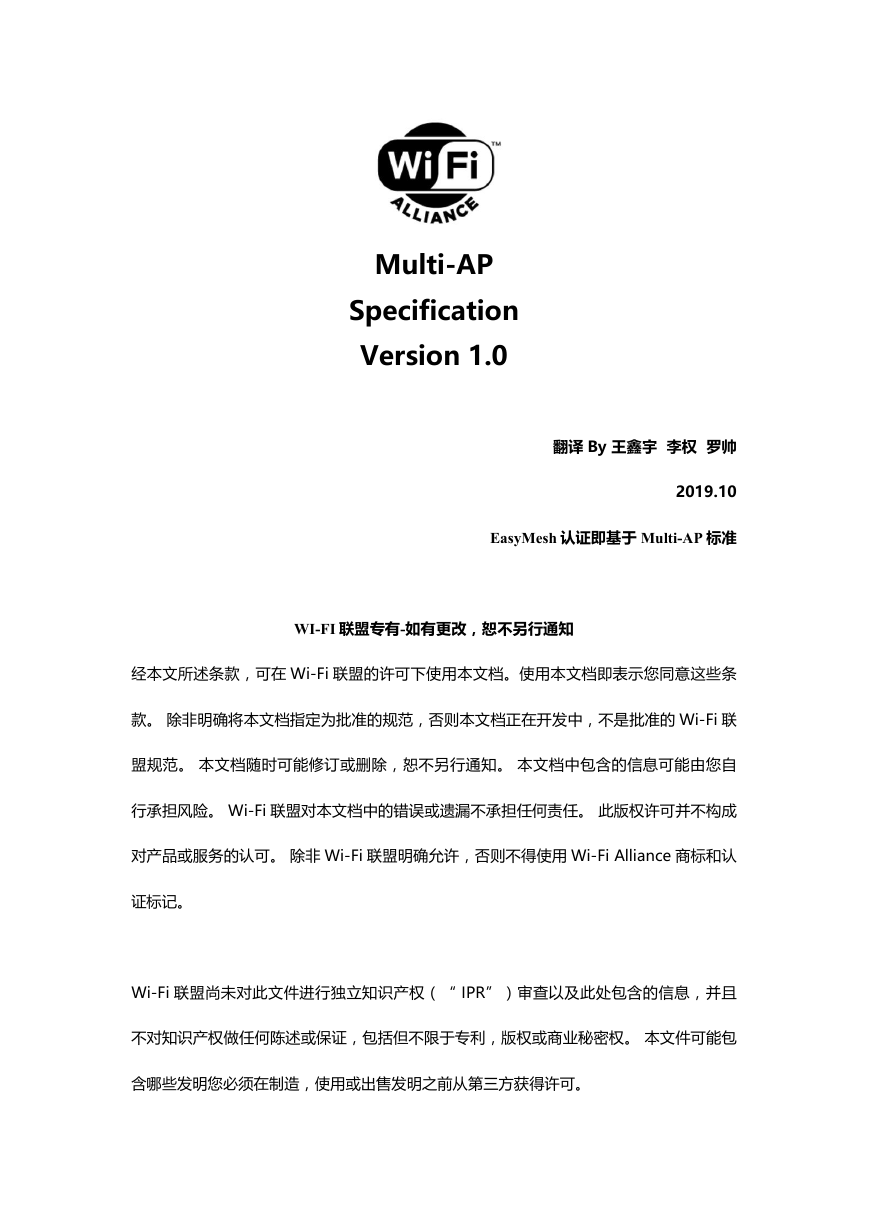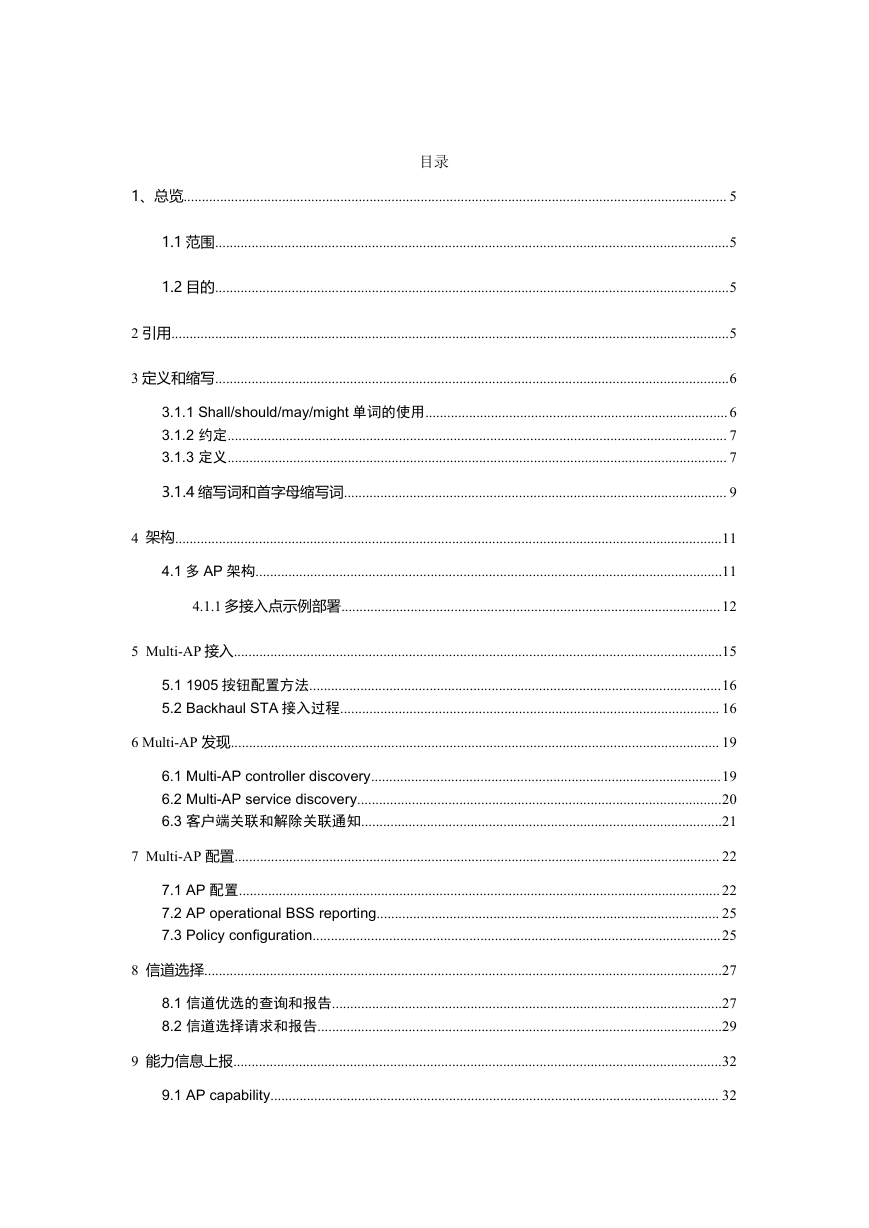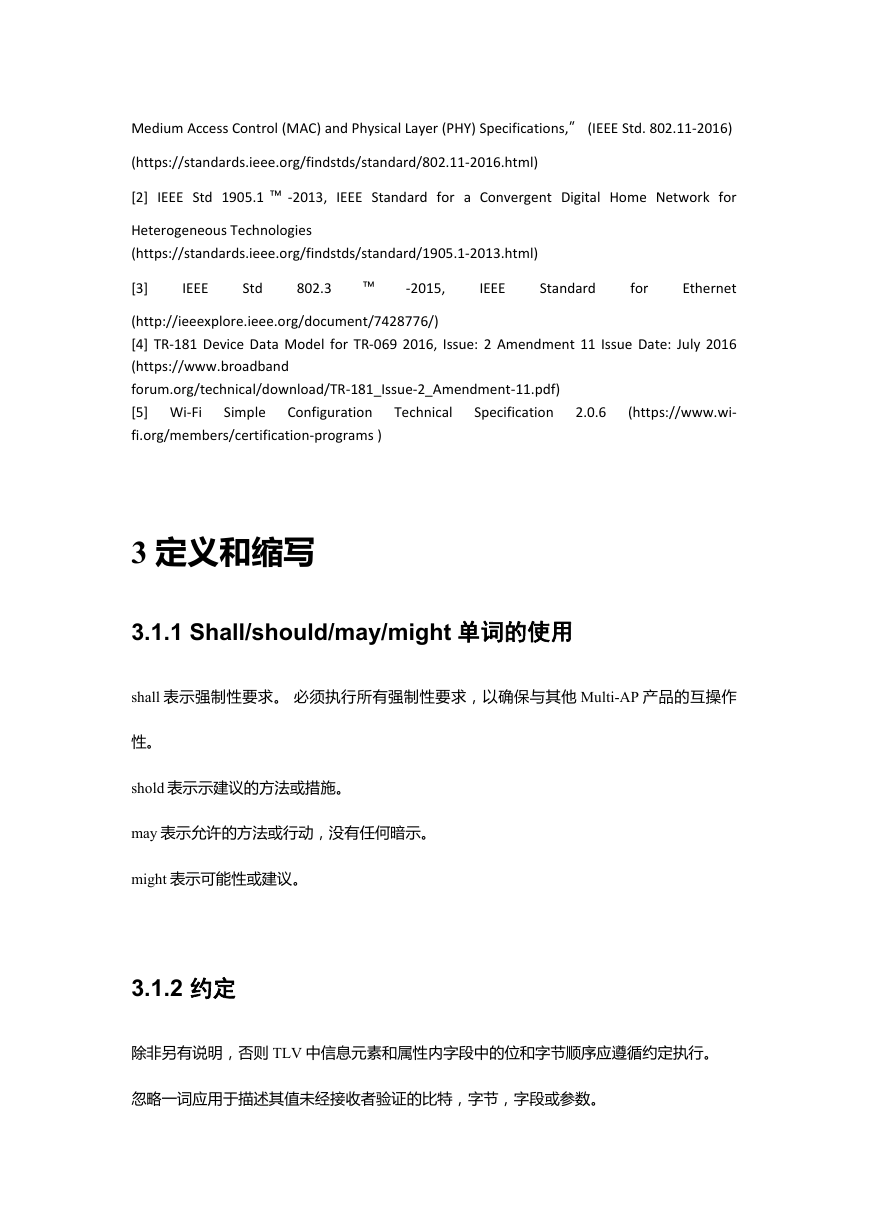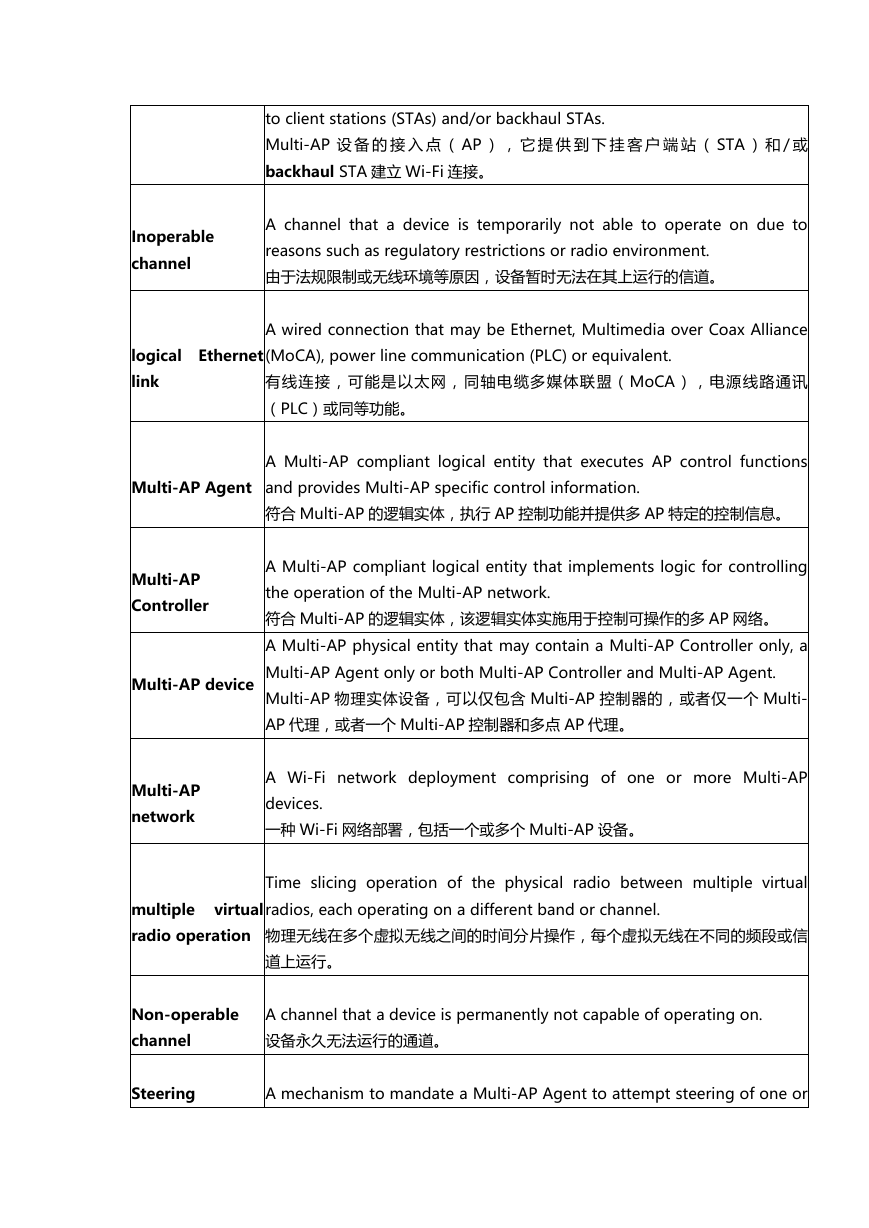Multi-AP
Specification
Version 1.0
翻译 By 王鑫宇 李权 罗帅
2019.10
EasyMesh 认证即基于 Multi-AP 标准
WI-FI 联盟专有-如有更改,恕不另行通知
经本文所述条款,可在 Wi-Fi 联盟的许可下使用本文档。使用本文档即表示您同意这些条
款。 除非明确将本文档指定为批准的规范,否则本文档正在开发中,不是批准的 Wi-Fi 联
盟规范。 本文档随时可能修订或删除,恕不另行通知。 本文档中包含的信息可能由您自
行承担风险。 Wi-Fi 联盟对本文档中的错误或遗漏不承担任何责任。 此版权许可并不构成
对产品或服务的认可。 除非 Wi-Fi 联盟明确允许,否则不得使用 Wi-Fi Alliance 商标和认
证标记。
Wi-Fi 联盟尚未对此文件进行独立知识产权(“ IPR”)审查以及此处包含的信息,并且
不对知识产权做任何陈述或保证,包括但不限于专利,版权或商业秘密权。 本文件可能包
含哪些发明您必须在制造,使用或出售发明之前从第三方获得许可。
�
Wi-Fi 联盟拥有本文档的版权,并保留其中的所有权利。 本文档的用户可以结合本文所述
的授权使用来复制和分发本文档的副本,只要其中的全部或部分副本包括本文所述的版权
声明和免责声明文本即可。 除非事先获得 Wi-Fi 联盟的书面许可,否则禁止对本文档进行
任何其他使用以及对该文档的所有其他复制和分发。 未经授权的使用,复制或分发是对
Wi-Fi Alliance 版权的侵犯。
WI-FI 联盟不做任何陈述或保证(无论是明示或暗示),并且 WI-FI 联盟不对任何直接,
间接,惩罚性,特殊,偶然,继发性或继发的或由于此类原因造成的损害负责。 与本文档
以及本文档中包含的任何信息的使用有关。
�
目录
1、总览..................................................................................................................................................... 5
1.1 范围.............................................................................................................................................5
1.2 目的.............................................................................................................................................5
2 引用.........................................................................................................................................................5
3 定义和缩写.............................................................................................................................................6
3.1.1 Shall/should/may/might 单词的使用...................................................................................6
3.1.2 约定......................................................................................................................................... 7
3.1.3 定义......................................................................................................................................... 7
3.1.4 缩写词和首字母缩写词......................................................................................................... 9
4 架构......................................................................................................................................................11
4.1 多 AP 架构................................................................................................................................11
4.1.1 多接入点示例部署........................................................................................................12
5 Multi-AP 接入......................................................................................................................................15
5.1 1905 按钮配置方法.................................................................................................................16
5.2 Backhaul STA 接入过程........................................................................................................ 16
6 Multi-AP 发现...................................................................................................................................... 19
6.1 Multi-AP controller discovery................................................................................................19
6.2 Multi-AP service discovery....................................................................................................20
6.3 客户端关联和解除关联通知...................................................................................................21
7 Multi-AP 配置..................................................................................................................................... 22
7.1 AP 配置.................................................................................................................................... 22
7.2 AP operational BSS reporting.............................................................................................. 25
7.3 Policy configuration................................................................................................................25
8 信道选择..............................................................................................................................................27
8.1 信道优选的查询和报告...........................................................................................................27
8.2 信道选择请求和报告...............................................................................................................29
9 能力信息上报......................................................................................................................................32
9.1 AP capability........................................................................................................................... 32
�
9.2 Client capability.......................................................................................................................33
10 Link metric collection(链路度量采集)......................................................................................... 34
10.1 Backhaul link metrics...........................................................................................................34
10.2 Per-AP link metrics.............................................................................................................. 35
10.2.1 Link metric measurements from the AP...................................................................... 35
10.3 Per-STA measurements..................................................................................................... 36
10.3.1 Associated STA link measurements from the AP........................................................36
10.3.2 Unassociated STA RCPI measurements from the AP................................................. 38
10.3.3 802.11 beacon measurements from the client.............................................................. 39
10.4 Combined infrastructure metrics........................................................................................41
11 Client steering................................................................................................................................41
12 Backhaul 优化....................................................................................................................................41
13 Multi-AP messaging security.....................................................................................................43
14 Four-address MAC header format........................................................................................... 43
15 Multi-AP control messaging reliability....................................................................................43
16 Higher layer data payload over 1905...................................................................................... 43
17 Multi-AP control messaging...................................................................................................... 43
�
1、总览
1.1 范围
本文档是 Wi-Fi CERTIFIED EasyMesh™(Wi-FiAlliance®认证计划)对于 Multi-AP
的技术规范。
该规范定义了 Wi-Fi®接入点(AP)之间的控制协议以及必要的数据对象来启用导入配
置,和控制多个 AP。
该规范也定义在 Multi-AP 网络内的 Wi-Fi 接入点之间路由流量的机制。
1.2 目的
本规范的目的是为了使来自不同供应商的 Wi-Fi 接入点(AP)设备能够在同一个 Wi-Fi 网
络部署。
2 引用
[1] IEEE Computer Society, “IEEE Standard for Information Technology – Telecommunications
and Information
Exchange Between Systems – Local and Metropolitan Area Networks – Specific requirements
Part 11: Wireless LAN
�
Medium Access Control (MAC) and Physical Layer (PHY) Specifications,” (IEEE Std. 802.11-2016)
(https://standards.ieee.org/findstds/standard/802.11-2016.html)
[2] IEEE Std 1905.1 ™ -2013,
IEEE Standard for a Convergent Digital Home Network for
Heterogeneous Technologies
(https://standards.ieee.org/findstds/standard/1905.1-2013.html)
[3]
IEEE
Std
802.3
™
-2015,
IEEE
Standard
for
Ethernet
(http://ieeexplore.ieee.org/document/7428776/)
[4] TR-181 Device Data Model for TR-069 2016, Issue: 2 Amendment 11 Issue Date: July 2016
(https://www.broadband
forum.org/technical/download/TR-181_Issue-2_Amendment-11.pdf)
[5] Wi-Fi
Specification
Configuration
fi.org/members/certification-programs )
(https://www.wi-
Simple
Technical
2.0.6
3 定义和缩写
3.1.1 Shall/should/may/might 单词的使用
shall 表示强制性要求。 必须执行所有强制性要求,以确保与其他 Multi-AP 产品的互操作
性。
shold 表示示建议的方法或措施。
may 表示允许的方法或行动,没有任何暗示。
might 表示可能性或建议。
3.1.2 约定
除非另有说明,否则 TLV 中信息元素和属性内字段中的位和字节顺序应遵循约定执行。
忽略一词应用于描述其值未经接收者验证的比特,字节,字段或参数。
�
保留一词应用于描述对象(位,字节或字段或其分配的值),其用法和解释将在将来由本
规范或其他技术规范/公告定义。 除非另有说明,否则保留对象应设置为零。 保留对象的
接收者应忽略其值,除非该对象在以后定义。 本技术规范定义的对象的发送者不得使用保
留的代码值。
3.1.3 定义
表 1 中的定义适用于本规范。
术语
说明
Air Time
The time-frequency spectral resources, normalized to the operating
bandwidth of the BSS. Therefore, if the predicted bandwidth of backhaul
transmissions is less than the BSS operating bandwidth (e.g. due to
dynamic bandwidth adjustment and/or HE OFDMA allocation), this is
factored in to the percentage of air time indicated.
时间频谱资源,是 BSS 拥有的带宽。 因此,如果回程传输的预测带宽小于
BSS 工作带宽(例如,由于动态带宽调整和/或 HEOFDMA 分配),这取决于指
示的广播时间百分比。
backhaul link
backhaul SSID
A Wi-Fi or wired logical Ethernet link between two Multi-AP devices in a
Multi-AP network.
这里指建立的 Mesh 链路,可以为有线或无线。
A Wi-Fi SSID used for a Wi-Fi backhaul link that is either the same or
different from the fronthaul SSID.
用于无 线 Mesh 链路连 接的 SSID,可以 与接入点 的 SSID 同一个 或不同的
SSID。
backhaul STA
A STA on a Multi-AP device with a Multi-AP Agent that provides Wi-Fi
connectivity with other Wi-Fi access points over the backhaul link.
可以通过无线连接到 Wi-Fi AP 点,并建立 backhaul link 的客户端
fronthaul AP
An access point (AP) of a Multi-AP device that provides Wi-Fi connectivity
�
to client stations (STAs) and/or backhaul STAs.
Multi-AP 设 备 的 接 入 点 ( AP ) , 它 提 供 到 下 挂 客 户 端 站 ( STA ) 和 / 或
backhaul STA 建立 Wi-Fi 连接。
Inoperable
channel
A channel that a device is temporarily not able to operate on due to
reasons such as regulatory restrictions or radio environment.
由于法规限制或无线环境等原因,设备暂时无法在其上运行的信道。
logical Ethernet
link
A wired connection that may be Ethernet, Multimedia over Coax Alliance
(MoCA), power line communication (PLC) or equivalent.
有线连接,可能是以太网,同轴电缆多媒体联盟(MoCA),电源线路通讯
(PLC)或同等功能。
Multi-AP Agent
A Multi-AP compliant logical entity that executes AP control functions
and provides Multi-AP specific control information.
符合 Multi-AP 的逻辑实体,执行 AP 控制功能并提供多 AP 特定的控制信息。
Multi-AP
Controller
Multi-AP device
A Multi-AP compliant logical entity that implements logic for controlling
the operation of the Multi-AP network.
符合 Multi-AP 的逻辑实体,该逻辑实体实施用于控制可操作的多 AP 网络。
A Multi-AP physical entity that may contain a Multi-AP Controller only, a
Multi-AP Agent only or both Multi-AP Controller and Multi-AP Agent.
Multi-AP 物理实体设备,可以仅包含 Multi-AP 控制器的,或者仅一个 Multi-
AP 代理,或者一个 Multi-AP 控制器和多点 AP 代理。
Multi-AP
network
A Wi-Fi network deployment comprising of one or more Multi-AP
devices.
一种 Wi-Fi 网络部署,包括一个或多个 Multi-AP 设备。
multiple
radio operation
virtual
Time slicing operation of the physical radio between multiple virtual
radios, each operating on a different band or channel.
物理无线在多个虚拟无线之间的时间分片操作,每个虚拟无线在不同的频段或信
道上运行。
Non-operable
channel
A channel that a device is permanently not capable of operating on.
设备永久无法运行的通道。
Steering
A mechanism to mandate a Multi-AP Agent to attempt steering of one or
�
















 2023年江西萍乡中考道德与法治真题及答案.doc
2023年江西萍乡中考道德与法治真题及答案.doc 2012年重庆南川中考生物真题及答案.doc
2012年重庆南川中考生物真题及答案.doc 2013年江西师范大学地理学综合及文艺理论基础考研真题.doc
2013年江西师范大学地理学综合及文艺理论基础考研真题.doc 2020年四川甘孜小升初语文真题及答案I卷.doc
2020年四川甘孜小升初语文真题及答案I卷.doc 2020年注册岩土工程师专业基础考试真题及答案.doc
2020年注册岩土工程师专业基础考试真题及答案.doc 2023-2024学年福建省厦门市九年级上学期数学月考试题及答案.doc
2023-2024学年福建省厦门市九年级上学期数学月考试题及答案.doc 2021-2022学年辽宁省沈阳市大东区九年级上学期语文期末试题及答案.doc
2021-2022学年辽宁省沈阳市大东区九年级上学期语文期末试题及答案.doc 2022-2023学年北京东城区初三第一学期物理期末试卷及答案.doc
2022-2023学年北京东城区初三第一学期物理期末试卷及答案.doc 2018上半年江西教师资格初中地理学科知识与教学能力真题及答案.doc
2018上半年江西教师资格初中地理学科知识与教学能力真题及答案.doc 2012年河北国家公务员申论考试真题及答案-省级.doc
2012年河北国家公务员申论考试真题及答案-省级.doc 2020-2021学年江苏省扬州市江都区邵樊片九年级上学期数学第一次质量检测试题及答案.doc
2020-2021学年江苏省扬州市江都区邵樊片九年级上学期数学第一次质量检测试题及答案.doc 2022下半年黑龙江教师资格证中学综合素质真题及答案.doc
2022下半年黑龙江教师资格证中学综合素质真题及答案.doc